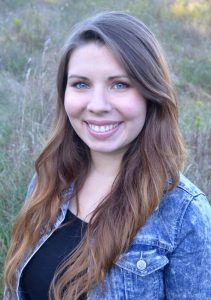Getting the Whole Picture
Blending social and ecological research helps focus wildlife species recovery efforts
Carly Sponarski spent much of her early academic career barking up the wrong tree, so to speak. It wasn’t until her Master’s degree that she finally branched off in a direction that matched her research and conservation interests.
Early on, Sponarski, now an assistant professor in the Department of Wildlife, Fisheries, and Conservation Biology and Mitchell Center Faculty Fellow, followed her heart and a desire to support conservation of animals by studying and taking a conservation biology approach. She had a light bulb moment near the end of her Bachelor’s degree.

“I was taking a course in field ecology and spending a lot of time outdoors alone examining spider species in a tropical rainforest in Ecuador,” Sponarski recalls. “At the end of my trip, I realized I’m not very good at being by myself for long periods of time, and that part of what I like about conservation research is being with and communicating with the people working on the project.”
For her Master’s degree, she decided to focus on the social science aspect of wolf management in southwest Alberta, which turned out to be a complicated issue for local residents. “I found myself jumping from biology into social science—as I believed taking a more human-centered approach would lead to insights that support conservation efforts of wolves in this region,” she notes.
At UMaine, Sponarski leads the Human Dimensions of Wildlife Lab in her department. The lab’s research focuses on the intersection of humans and natural resources, by examining the social impacts of resource management—the community interactions, associated conflicts, and decision-making.
In the last decade, the merit of understanding both the ecological and human sides of conservation issues has come to the forefront,” Sponarski says. “For example, people working in the biological sciences are understanding that the wildlife they’re trying to conserve are interacting with human beings in a variety of ways. And without incorporating humans into the ecosystem context, you’re really not getting the complete picture.”
Sponarski and her faculty colleagues, Bridie McGreavy, Aaron Strong and Joe Zydlewski, developed a project called “Getting Over the Dam” using Atlantic salmon as the case study species. The Atlantic salmon population in Maine remains critically low despite extensive hatchery supplementation and habitat improvement efforts over the past four decades.
The aim of this project is to gain a better understanding of how communication between people within and between government agencies can affect how endangered species such as Atlantic salmon are managed under the Endangered Species Act (ESA).
“When trying to understand gaps in policy, we are missing a critical component— people. People are interacting with the policy, and with others from within and outside their government organization all the time, which invariably makes management of an endangered species complicated and messy.”
Sponarski adds, “For example, we might do our best to write policy to make it functional for the people using it, but the policy inevitably is interpreted by different individual and groups of people working within an organization.”
And the different work cultures in each agency can either help or hinder the process of species recovery in terms of how well people can actually work together. For example, does each agency have the same vision on how to recover a species? Or does each agency agree on what’s the best course of action?
Lab work
In Sponarski’s lab they study “how people value wildlife, how they want wildlife to be managed and how they are affected or affect wildlife management decisions,” she says quoting Daniel Decker, director of the Human Dimensions Research Unit at Cornell University.
Supported by a Mitchell Center seed grant, the Getting Over the Dam project aims to assess the social factors of a complex governance system—the Atlantic Salmon Recovery Framework (ASRF)—put in place for the recovery process that involves a host of regulators and managers from federal and state agencies and the Penobscot Nation.

Her project includes a communication network analysis to see how people are communicating to get a better sense of what aspects of collaboration they think is going really well versus aspects they see as barriers to Atlantic salmon recovery. Master’s student Melissa Flye is leading the effort.
“Melissa is currently surveying all the government agencies, indigenous groups and key non-governmental organizations that are involved in Atlantic salmon recovery in Maine,” says Sponarski.
For example, the ASRF is comprised of different action teams with each government agency and indigenous group represented. The ASRF is designed to help with collaboration, information sharing, and decision-making, but, Sponarski asks, “how well is it supporting species recovery planning? This is the aspect we are interested in understanding.”
“The ASRF is a very complex management system, and we might find that one of the barriers is communication among the action teams. The communication network analysis will provide us with insights into communication barriers and strengths.” Sponarski says. “For instance, email is great means of communication—it’s fast, but it generally might not be the best way to discuss a complicated issue or decision that needs to be made. So one potential way to improve communication would be to have more group meetings.”
Human Dimensions of Wildlife Lab Students
Other students in Sponarski’s lab include Ph.D. students Kirstie Ruppert and Elyse DeFranco, Master’s student Francesca Gundrum, and undergraduate students Kiley Davan and Mike Buyaskas.
Ruppert’s research is based in the conservancies of northern Kenya, where she works in partnership with pastoralist communities to study the human dimensions of giraffe conservation.
DeFranco works on a human-deer interactions project in New Brunswick where she’s trying to understand the different conflicts that are evolving out of winter deer feeding.
And Gundrum is using two approaches to understand differences in public opinion regarding black bear hunting in Maine: a media analysis of newspaper articles printed during the November 2014 election referendum question that called for a ban on the baiting, hounding, and trapping of black bears in Maine and was narrowly defeated; and semi-structured interviews with major stakeholders.
Sponarski along with UMaine collaborations Allison Gardner, Jessica Leahy, and Anne Lichtenwalner and Laura Kenefic of the U.S. Forest Service will be embarking on a new project in 2019 investigating the impacts of forest management practices on the ecology and dynamics of tickborne disease transmission. The team’s goal is to devise strategies to protect forest worker health that are compatible with private landowners’ forest and wildlife management priorities. The project is funded by the U.S. Department of Agriculture.
—David Sims
